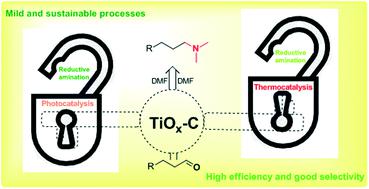当前位置:
X-MOL 学术
›
React. Chem. Eng.
›
论文详情
Our official English website, www.x-mol.net, welcomes your
feedback! (Note: you will need to create a separate account there.)
One catalyst for two uses: TiOx–C acts as either a photocatalyst or thermocatalyst to promote reductive amination
Reaction Chemistry & Engineering ( IF 3.4 ) Pub Date : 2021-10-24 , DOI: 10.1039/d1re00294e Shun Wang 1 , Xinli Tong 1 , Lingwu Meng 1 , Yujun Zhao 2
Reaction Chemistry & Engineering ( IF 3.4 ) Pub Date : 2021-10-24 , DOI: 10.1039/d1re00294e Shun Wang 1 , Xinli Tong 1 , Lingwu Meng 1 , Yujun Zhao 2
Affiliation

|
The selective reductive amination of carbonyl compounds is efficiently promoted using titanium oxide uniformly doped with carbon (TiOx–C), either as a photocatalyst or thermocatalyst. For the reductive amination of 3-phenylpropanal, 82.7% conversion of 3-phenylpropanal and 99.0% selectivity of N,N-dimethyl-3-phenylpropan-1-amine was achieved using TiOx–C as a photocatalyst at room temperature under visible light irradiation. In addition, 98.9% conversion with 99.0% product selectivity was attained at 90 °C under no light when TiOx–C was employed as a thermocatalyst. Therein, the efficient separation of photogenerated electron and holes of TiOx–C is the key factor during the photocatalytic process; while, the acidic sites of the surface and oxygen vacancies of TiOx–C are responsible for its high efficiency in the thermocatalytic reductive amination reaction.
中文翻译:

一种催化剂有两种用途:TiOx-C 作为光催化剂或热催化剂促进还原胺化
使用均匀掺杂碳的氧化钛 (TiO x -C) 作为光催化剂或热催化剂,可以有效地促进羰基化合物的选择性还原胺化。对于 3-苯基丙醛的还原胺化,使用 TiO x -C 作为光催化剂在室温可见光下实现了82.7% 的 3-苯基丙醛转化率和 99.0% 的N , N-二甲基-3-苯基丙-1-胺的选择性辐照。此外,当 TiO x -C 用作热催化剂时,在 90 °C 和无光照条件下实现了 98.9% 的转化率和 99.0% 的产物选择性。其中,TiO x的光生电子和空穴的有效分离-C是光催化过程中的关键因素;同时,TiO x -C表面的酸性位点和氧空位是其在热催化还原胺化反应中高效的原因。
更新日期:2021-11-16
中文翻译:

一种催化剂有两种用途:TiOx-C 作为光催化剂或热催化剂促进还原胺化
使用均匀掺杂碳的氧化钛 (TiO x -C) 作为光催化剂或热催化剂,可以有效地促进羰基化合物的选择性还原胺化。对于 3-苯基丙醛的还原胺化,使用 TiO x -C 作为光催化剂在室温可见光下实现了82.7% 的 3-苯基丙醛转化率和 99.0% 的N , N-二甲基-3-苯基丙-1-胺的选择性辐照。此外,当 TiO x -C 用作热催化剂时,在 90 °C 和无光照条件下实现了 98.9% 的转化率和 99.0% 的产物选择性。其中,TiO x的光生电子和空穴的有效分离-C是光催化过程中的关键因素;同时,TiO x -C表面的酸性位点和氧空位是其在热催化还原胺化反应中高效的原因。











































 京公网安备 11010802027423号
京公网安备 11010802027423号